-
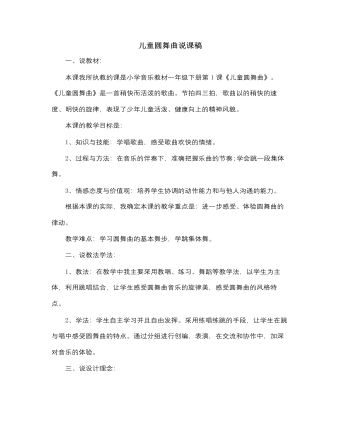
人音版小学音乐一年级下儿童圆舞曲说课稿
本课我采用欣赏《杜鹃圆舞曲》的片断导入新课,挖掘学生已有的对圆舞曲特点的了解,让学生快速进入学习情境,增加学生对圆舞曲学习的兴趣。导入完新课以后,我遵循音乐是听觉的艺术,从聆听入手学唱歌曲,第一次听录音的范唱,让学生聆听音乐,了解歌词的内容。第二次教师有感情的演唱,激发学生听的兴趣,加深学生对歌曲的节拍情绪的理解和感受。在歌曲旋律唱会后,学生自然地就能演唱这首歌曲,知识技能的掌握渗透在歌曲学唱之中。让学生在轻松愉悦的氛围中短时高效的学会歌曲。为了开发学生的创造性潜智,在学会歌曲以后,我设计了舞蹈创编这个教学环节。舞蹈创编就是学生对音乐的再度创作,是发挥学生想象力和思维潜能的学习领域,是学生积累音乐创作经验和发掘创造思维能力的过程和手段,对于培养具有实践能力的创新人才,具有十分重要的意义。让学生的身心、肢体与音乐密切结合,让学生在创编合作中体验快乐,表现快乐。
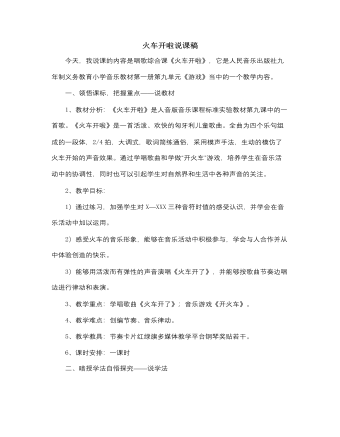
人音版小学音乐一年级下火车开啦说课稿
6、你言我语尽情唱游开火车的唱游对于学生来说是没有什么难度的,我不想手把手的教,而是想让孩子自己摸索出开好火车的方法,于是我说“想把火车开好可不是一件容易的事情,因为火车有好多车厢连在一起,怎么把它连起来?怎么开,我们一起来商量一下。学生有很多方法有的建议拉着前面同学的衣服、搭着前面同学肩膀,我让学生跟我一起来演示,一起研究,大家一起决定什么动作比较好。最后,师生都认同右手搭在前面同学肩膀,左手做车轮滚动的样子。就这样,一列列小火车很快就能够上路了。在唱游过程中,学生不可避免的是相互碰撞,这时停下音乐,宣布:“现在发生了交通意外,请各辆小火车赶快回到自己的位置。”一起讨论怎样才能安全行驶,相互不让路,不喧哗。7、开动火车乐趣无限唱游结束后,我安排了一个游戏:音乐中,两列小火车在教室里自由行驶,音乐停下时到站请旅客上车,音乐开始后继续旅行,直到所有的乘客都上车。这个游戏的设计也是为了让学生体会共同游戏的乐趣,在游戏中学会礼让,安全驾驶。
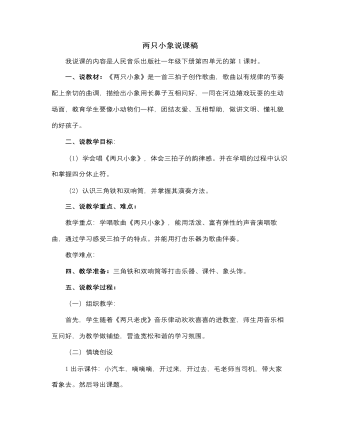
人音版小学音乐一年级下两只小象说课稿
又能再次让学生体会三拍子的韵律感。在配打击乐器为歌曲伴奏这个环节我通过“看图片、找乐器、读节奏、选节奏、敲乐器”等活动充分调动学生学习的积极性,再次掀起学生们的学习乐趣。五、总结:今天我们在动物园和小动物们度过了愉快的一天,我们应爱护小动物,和它们做朋友,而且更要像小动物们一样,团结友爱、互相帮助,做懂礼貌的好孩子。并预告下节课将做象头饰及分小组比赛表演。(在《两只小象》音乐中律动出教室。)总体来说,本方案的设计利用多媒体为学生创设一种生动、直观的教学情景,通过看、听、唱、舞等手段,充分调动了学生的兴趣和积极性,同时在各种音乐活动中,充分体现了学生自主、合作、探究的学习方式,使学生会学、乐学、敢学,将学生自主学习与创新意识的培养落到了实处.
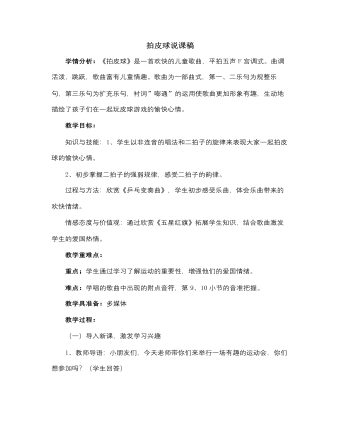
人音版小学音乐一年级下拍皮球说课稿
多媒体反复播放童声齐唱歌曲《五星红旗》,出示歌谱歌词,画面滚动播放各种五星红旗升起的情景以及运动健儿为国争光的一瞬间。(鼓励学生站起来,可以加上拍手的一些动作跟着音乐边唱边体会歌曲情绪,把课堂推向高潮。)师:小朋友们,当国歌再次奏起,看到冉冉升起的五星红旗,我们的心情是多么的激动,我们一起来呼喊”五星红旗,我们的国旗,我们热爱您”(学生跟着老师一起呼喊)。让我们用自己的歌声来表达我们此时的心情吧。设计意图:通过《五星红旗》的欣赏,升华对祖国的热爱之情。(四)总结下课奥运健儿们的那种顽强的奥运精神,坚强的毅力,都是值得我们小朋友一起学习的,我们就从最简单的拍皮球,跳绳开始吧,好好锻炼身体,将来在各种岗位上为国家争光。
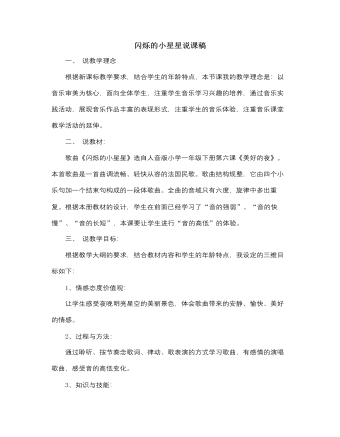
人音版小学音乐一年级下闪烁的小星星说课稿
3、小结:本节课我们听唱了三首不同风格的关于星空的音乐作品,同学们还可以收集更多此类歌曲听一听,感受夜晚星空之美。十、 说板书设计:首先,板书课题时用小星星的图案代替文字,更加吸引学生,容易激发学生的学习兴趣。其次,本节课的板书主要体现乐理知识:反复记号;柯达伊手势图谱。板书目的帮助学生解决学习中的难点。十一、说教学反思:亮点:教师根据学生的身心特点及学习情况有目的、有计划的引导学生进行学习,以达到教学目标。根据学生已有知识,运用柯达伊手势教学法,在准确演唱歌曲的基础上,学唱歌谱,帮助学生建立音高概念,完整的演唱歌曲。成功解决本课教学的难点,完成教学目标。不足之处:教师对于学生律动表演的规则讲解不到位,学生操作不熟练。专业术语使用不到位、不规范,有待于进一步改进和提高。
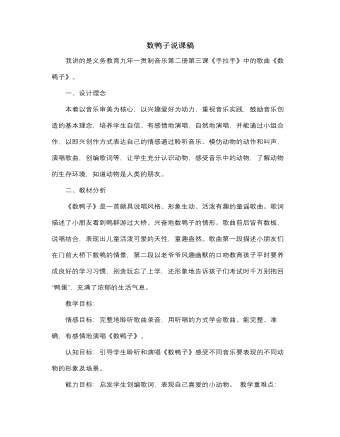
人音版小学音乐一年级下数鸭子说课稿
①谈话引入:“小朋友们喜爱的小动物还有很多很多呢,你们能给其他动物编上歌词并说出来吗?”让我们来当“小小作词家吧”。 ②鼓励学生进行创编。 ③选择几种,跟着音乐一起唱。 (培养学生的音乐创造能力,同时引导学生要关于观察、关于模仿,通过模仿,由易到难、循序渐进地进行创造。 4、小结 师:动物是人类的朋友,我们要保护动物,爱护动物。听着小朋友们美妙的歌声,看着大家亲密无间的合作,老师心里无比的高兴。同学们还可以把小动物们请到我们的歌曲中来,和他们成为好朋友,你们可真的很能干! 整个教学过程从一开始的律动,后来的模仿到创编和即兴表演,运用感知法、认知法、学唱法,让学生用有感情的演唱和肢体语言表达对小动物的喜爱之情。通过创编,培养合作精神和创新能力,获得成功的喜悦。使学生的演、唱、创新、合作能力得到很好的发展,并渗透了思想教育。
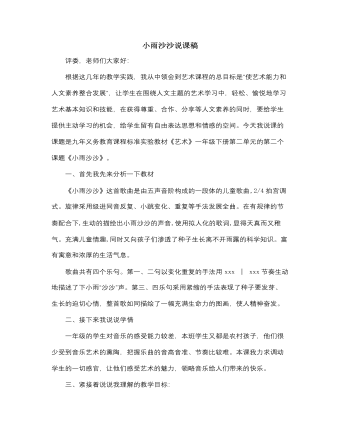
人音版小学音乐一年级下小雨沙沙说课稿
课堂小结部分,我设问“甘甜的雨露滋养种子,帮助种子成长,问学生们喜欢小雨吗?”学生回答后,我进一步诱导:“种子的生长离不开雨水的滋润,你们的成长离不开谁呢?”学生讨论回答(爸爸、妈妈、老师、祖国??)接着教导学生要热爱祖国,孝敬父母,尊敬老师。从现在做起,用优异的成绩来报答他们。 然后对学生这堂课的表现作一个简单的评价,伴随着音乐出教室。最后我总结一下我对这节课的理解和设计。新课改赋予了音乐课五彩缤纷的舞台,给学生的发展提供自由的空间,本课我充分发挥学生的主体作用,让学生成为课堂的主人,让学生在音乐中动起来,给课堂注入新鲜的"血液",让学生徜佯在音乐的世界里自由的发展,并体验到学习音乐的乐趣,真正快乐地享受音乐。 谢谢大家!
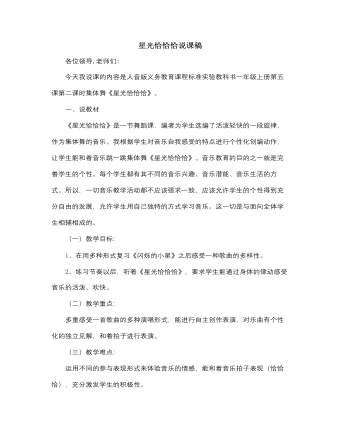
人音版小学音乐一年级下星光恰恰恰说课稿
为了进一步激发学生表演,我特意加上了舞蹈比赛这一环节, 每两小组分别表演,其他四个小组投票选择,选出优胜组,最后胜出的三个小组,再向大家展示。让学生多练多跳,激发起学生的参与意识.四、发展阶段让学生思考能变换什么队形,两人结伴或者几个人,学生自己编创组合队形。在本节课中,这个环节比较符合教学内容,通过自己的创作体验,学生就有了创新,有了突破,这就是创造性的体现,也是发展个性的体现.五、总结阶段本课我采用了归纳式的结尾,来归纳本课的教学内容,提出优点,缺点及改正方向.本课的课件为图文结合法,目的是激发情趣.,重点突出,一目了然,充分展现乐曲意境,让学生有身临其境之感.总之本课的设计考虑到了音乐学科的特点,课时的教学任务,学生的年龄特点等因素,运用各种教学媒体辅助教学,尤其是电脑媒体的介入,应该能使得课堂气氛活跃,让学生的学习兴趣,始终处于积极状态,充分体现了音乐、美术加以综合的审美育人功能.
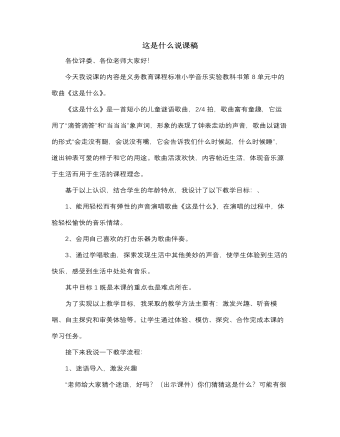
人音版小学音乐一年级下这是什么说课稿
新课标指出,在教学中应注意培养学生自信的演唱,演奏能力及综合性艺术表演能力。我通过举办小小音乐会,把学生分成乐器组和表演组,乐器组的同学使用打击乐为歌曲伴奏,表演组的同学即兴创编动作,让学生在歌表演伴奏教学活动中鼓励学生大胆模仿、想象,培养学生即兴表演能力和人与人这间的合作精神,并让学生在活动中享受美的愉悦,受到情感陶冶,从而把课堂推向高潮。4、深化主题,拓展视野为了拓展学生的音乐视野,深化课堂,我鼓励学生探索和发现生活中其它美妙的声音,(出示课件)“闹钟是我们身边的好朋友,你身边还有哪些能发出响声的好朋友呢?你能不能把他们也变成音乐唱出来呢?”这样让学生感受到生活中处处有音乐,并且挖掘了教材的真正意图,体现音乐课的真正价值。孩子们在歌声中结束了本课的学习,意犹未尽。
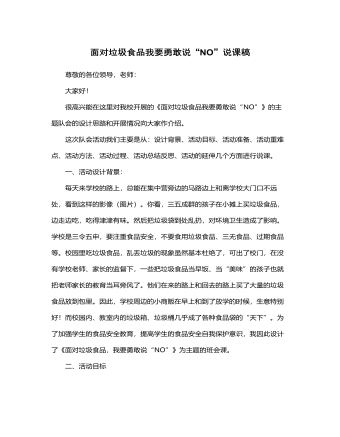
面对垃圾食品,我要勇敢说“NO” 说课稿
二、从我做起,养成良好的饮食卫生习惯,严防病从口入。坚持做到勤洗手、勤剪指甲、勤洗澡理发、勤换衣报,不喝生水,不吃腐烂变质的食物,少吃生冷、凉拌的食物。三、增强自我保护意识。不买、不吃无厂名厂址、无生产日期、无保质期的“三无”食品和过期变质食品,不买街头巷尾无照无证的小商小贩出售的各类食品。四、养成良好的饮食习惯。一日三餐定时定量吃饭,不暴饮暴食,建立合理的生活作息制度。多了解健康食品知识,防止急性肠胃炎和肠道传染病等疾病的传播,防止食物中毒和肠道传染病的发生;外出就餐要选择卫生洁净、餐具消毒、环境整洁有序的正规餐馆、饭店。四、养成良好的卫生习惯。不喝生水,不随便在校园内吃零食、不乱扔纸屑、包装袋、糖纸等垃圾,保持良好的校园卫生环境,争做环保小卫士。同学们,民以食为天,食以安为先。为了我们的身体健康,让我们行动起来,关注食品安全,增强食品安全意识,养成良好的饮食卫生习惯,杜绝疾病的发生,共建健康和谐的校园环境!

人教版小学语文下册说课稿《学弈》《两小儿辩日》
一、说教材 1.教材内容:九年义务教育六年制小学语文第十一册第八组第二十五课《学弈》。 2.教材简析:《学弈》这篇文言文选自《孟子·告子》,通过弈秋教两个人学下围棋的事,说明了做事必须专心致志,决不可三心二意的道理。文章先说弈秋是全国最擅长下围棋的人,然后讲弈秋同时教两个学习态度不同的人下围棋,学习效果截然不同,最后指出这两个人学习结果不同,并不是在智力上有多大差异。文言文是古代文明传承的媒介,虽与现代文在用词造句、朗读上有很大差别,但两者却有着千丝万缕、不可分割的内在联系
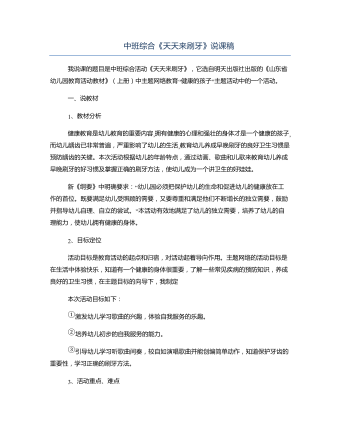
中班综合《天天来刷牙》说课稿
健康教育是幼儿教育的重要内容,拥有健康的心理和强壮的身体才是一个健康的孩子,而幼儿龋齿已非常普遍,严重影响了幼儿的生活,教育幼儿养成早晚刷牙的良好卫生习惯是预防龋齿的关键。本次活动根据幼儿的年龄特点,通过动画、歌曲和儿歌来教育幼儿养成早晚刷牙的好习惯及掌握正确的刷牙方法,使幼儿成为一个讲卫生的好娃娃。新《纲要》中明确要求:“幼儿园必须把保护幼儿的生命和促进幼儿的健康放在工作的首位。既要满足幼儿受照顾的需要,又要尊重和满足他们不断增长的独立需要,鼓励并指导幼儿自理、自立的尝试。”本活动有效地满足了幼儿的独立需要,培养了幼儿的自理能力,使幼儿拥有健康的身体。
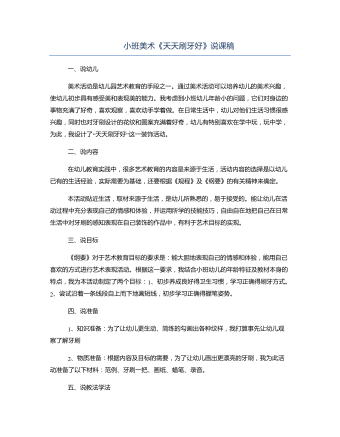
小班美术《天天刷牙好》说课稿
美术活动是幼儿园艺术教育的手段之一。通过美术活动可以培养幼儿的美术兴趣,使幼儿初步具有感受美和表现美的能力。我考虑到小班幼儿年龄小的问题,它们对身边的事物充满了好奇,喜欢观察,喜欢动手学着做。在日常生活中,幼儿对他们生活习惯很感兴趣,同时也对牙刷设计的花纹和图案充满着好奇,幼儿有特别喜欢在学中玩,玩中学,为此,我设计了“天天刷牙好”这一装饰活动。在幼儿教育实践中,很多艺术教育的内容是来源于生活,活动内容的选择是以幼儿已有的生活经验,实际需要为基础,还要根据《规程》及《纲要》的有关精神来确定。本活动贴近生活,取材来源于生活,是幼儿所熟悉的,易于接受的。能让幼儿在活动过程中充分表现自己的情感和体验,并运用所学的技能技巧,自由自在地把自己在日常生活中对牙刷的感知表现在自己装饰的作品中,有利于艺术目标的实现。
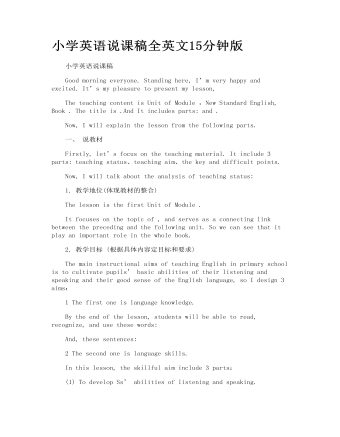
小学英语说课稿全英文15分钟版
一、 说教材 Firstly, let’s focus on theteaching material. It include 3 parts: teaching status、teachingaim、the key and difficult points. Now, I will talk about the analysis of teaching status: 1. 教学地位(体现教材的整合) The lesson is the first Unit of Module . It focuses on the topic of , and serves as a connectinglink between the preceding and the following unit. So we can see that it playan important role in the whole book. 2. 教学目标 (根据具体内容定目标和要求) The main instructional aims of teaching English inprimary school is to cultivate pupils’ basic abilitiesof their listening and speaking and their good sense of the English language,so I design 3 aims:

人教版高中英语必修1English around the world说课稿
(3)v. 给:提出;展现,显现present sb. with sth. ; present sth. to sb. 把. . 交给;颁发;授予present sth. (for sth. )/present sth. to sb. e. g. Om his birthday, his friends presented him a collection of stamps. 在他生日时,他的朋友们送给他一套邮票作为礼物。The sword was presented by the family to the museum. 这家人把宝剑捐赠给了博物馆。The committee will present the final report to Parliament in June. 委员会将在六月向议会提交最后的报告。You need to present yourself better. 你需要更善于展现自己。It is essential that we present a united front. 至关重要的是我们要表现得更加团结。Step 4 ConsolidationT:Now that we have got a general idea of these words and phrases. Lets make up some sentences using them to master them. Suggested sentences:1. Your duties include typing letters and answering the telephone. 2. It is one of the greatest roles that she has played. 3. A large number of people have applied for the job. 4. The number of the panda is declining. 5. I'11 go there, even if I have to walk. 6. He came up to me to ask for a light. 7. The novel is about a family who can't communicate with each other. 8. He based his plan on interests of most people. 9. Why doesn't he make use of his singing talent?Step 5 Summary and homeworkT:Today we dealt with several new words and phrases. After class I hope that youcan read them again and again to keep them in mind. That's all for today. You aredismissed.

人教版高中英语必修2The Olympic Games说课稿2篇
Purpose of my design:To ask the students to do these two tasks will make the Ss predict the story of this passage. As a result, it will deepen Ss’ memory of this story because they will have their own understanding of this story.Step 3. While-readingTask 1. (Individual work _____min)Skimming: ask students to skim the text and the main ideas of each paragraph in this passage. Please read it quickly and then match the sentences with the letters.Task 2. (Individual work _____min)Scanning: read the text quickly and decide the whether the following statements are true or false and give reasons.Task 3. (Pair work _____min)Listen to the tape and fill in the banks. Then read the paragraph with expression to your partner.Task4 (individual work min)Listen to the tape again and write down the main idea in one sentence.Purpose of my design: Enable students to understand the given material better by using different reading skills. And proper competition can arouse the Ss’ interest in English learning. “Task-based” teaching method is used here todevelop the Ss’ ability of communication and also their ability of co-operation will be well trainedStep 4. Post-readingTask 1. (Individual work, pair work, group work, class work; _____min)Discussion (group of 4):1. If you were Hippomenes, would you run against Atlanta?2. Do you think Hippomenes deserved to win the race? Why or why not?Step 5. HomeworkPlease read the story again carefully after class and imagine: What will happen during the race between Hippomenes and Atlanta? Who do you think will win the race? Do you think Atlanta would marry Hippomenes? Write an end for the story with thses questions.Purpose of my design: Homework is so important and necessary for to master the knowledge they learned after class. It will check whether the Ss achieve the teaching aims.Part 5 Blackboard design

人教版高中英语必修4Women of achievement说课稿4篇
Good morning, distinguished judges:It’s my honor to talk about my teaching ideas with you. Today my topic is Women of Achievement. My presentation consists of six parts: the analysis of teaching material and student, teaching aims, key and difficult points, teaching and studying method, teaching procedures and blackboard design.First, let’s focus on the analysis of teaching material. This lesson is from New Senior English for China Student’s Book 4 Unit 1, the reading part. The main topic of the passage is the introduction of a student of Africanwildlife. After this lesson, the students will learn more information about her studying chimps in Africa, and their reading and speaking abilities can be developed as well.The next part is the analysis of students. My students are in senior high students. They have learnt English for many years, they’ve known many words and sentences, but their speaking and reading abilities are still not very good. So I will practice their speaking and reading abilities through different exercises.According to the New Standard Curriculum and the present situation, I set the teaching aims as follows: firstly, knowledge aims. Students can grasp some new words, such as worthwhile, move off. Moreover, students can understand the content of the passage and get familiar with the topic of studying chimps in wildlife. Secondly, ability aims. Students can use reading strategies such as skimming and scanning in reading process. Thirdly, emotional aims. Students can have the awareness of protecting animals and care about animals.Based on the above analysis, the key point of this lesson is to get the main idea and the detailed information from the passage; the difficult point is to talk about the wildlife protection and use reading strategies.

人教版高中英语必修3The million pound bank note说课稿3篇
在接下来的细读环节,我套用了高考对阅读理解的考查方式设置了5个问题,分别为三个推理判断题,一个细节题和一个主旨大意题。学生需要对文章的内容进行分析、归纳、推理、猜测等高级思维活动才能做出正确的回答。【设计意图】这一过程是对学生进行细读的训练,培养学生获取特定信息和挖掘文章深层次信息的能力。第三环节:Intensive-reading (精读) 15′第三个环节精读,既是最重要的环节,也是突破本课重难点的关键。首先,让学生思考剧本中人物看到百万英镑前后的态度发生了怎样的变化。其次,让学生仔细阅读文章,找出可以表现人物态度变化的具体的语言和动作。最后,让学生总结人物的态度发生变化的根本原因是什么,从而引出Money Talks, 供学生思考。【设计意图】通过一系列的活动培养学生学习从人物的语言和动作探究人物的心理,使学生进一步体会戏剧语言的魅力,从而对文章背后所反映的社会问题进行思考,也为下一步的讨论环节做好铺垫。

人教版高中英语必修5The United Kingdom说课稿4篇
Teaching Aims:Knowledge 1. Get the students to learn the useful new words and expressions in this section. Aims:2. Let the students learn about how the UK was formed and the four groups of invaders.1. Develop students’ reading ability and let them learn different Ability reading skills. Aims:2. Enable students to learn to talk about the United Kingdom and the Union Jack Emotional 1. Let students know more about the UK2. Develop students’ sense of cooperative learning Aims:Teaching Important Points:1. Let the students learn about the countries of the United Kingdom and the Union Jack2. Get the students to read the passage and know about how the UK was formed and the four groups of invaders.3. Have the students learn different reading skills.Teaching Difficult Ponts:1. Develop students’ reading ability.2. Enable students to talk about the United Kingdom and the Union Jack.3. Let students learn how the UK was formed geographically and historically.Teaching Methods:Showing pictures, asking, exercising, listening, reading etc.Teaching Aids:A computer,a projector and a blackboard.Teaching Procedures: 1) Show a map of the world, ask students the following questions:Where is the UK?What’s the full name of the UK?2) Ask the students work in pairs to do the quiz on Page 9.Do you want to test how many things you know about the United Kingdom? Let’s have a small test.Using the map on P9, students answer the following questions:?How many countries does the UK consist of? What are they??England is divided into three main areas. Do you know what they are? 1) Scanning (10Minutes )Let the students hold the questions asked in pre-reading and read the passagequickly and then let them do the following exercise.Join lines to the right answer.

人教版高中英语必修1Journey Down the Mekong说课稿
2. let the Ss complete the forms paragraph by paragraph. Purpose here is to help Ss to get the habit of reading a passage as a whole, and pay attention to the organization of the text, as a result the Ss will fully understand the whole passage.3. ask Ss to retell the passage with the help of the key words in the form.Since the Ss in the class are in different levels, so I let them to fill in the blank to understand the meaning of the words and phrases better. ( That’s all for the while-reading. Now let’s move to the fifth step.)Step V: Post-reading (10mins) ---DiscussionIn this part students are asked to discuss in groups and list Wang Kun’s and Wang Wei’s attitudes about the trip. After that, Ss are encouraged to express their attitudes with the whole class. Collect their answers and don’t forget to praise them even if their answers may not be perfect.In this activity, discussion provides a vivid and active learning environment for Ss to communicate in English with newly learned language items. (Finally it comes to the homework.)StepⅥ: Homework (1min)1. Ss are required to read the text again after class and figure out the meaning of some complex sentences.2. Do the exercises on P19; This can help Ss to consolidate what they’ve learnt and make preparation for the next lessonPart4. Blackboard design.(说板书设计)On the top, there is the title of this lesson. On the left, there are main ideas for each paragraph. On the right, there are some new words and expressions.Unit 3 Travel journalJourney down the MekongMain idea of each para.:Para1: deciding to take a great bike trip along the Mekong river.Para2: Different attitudes between Wang kun and Wang wei.
